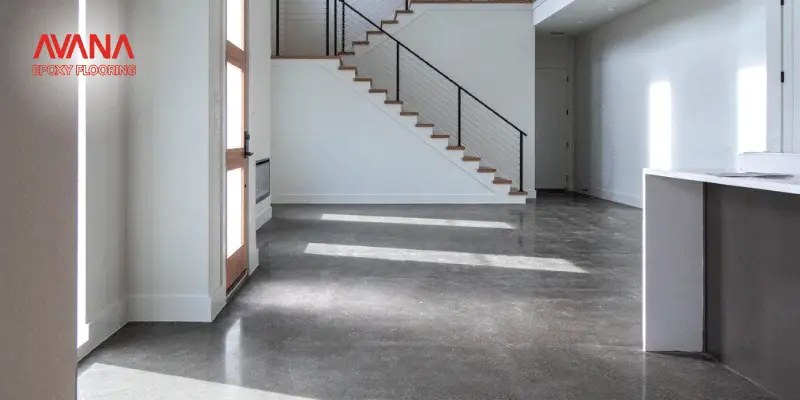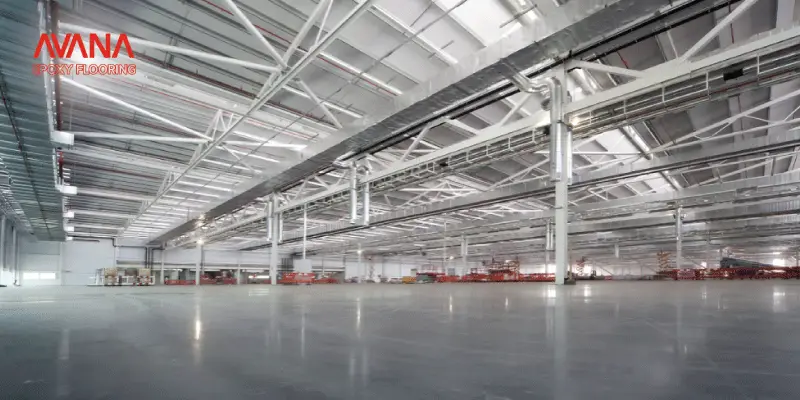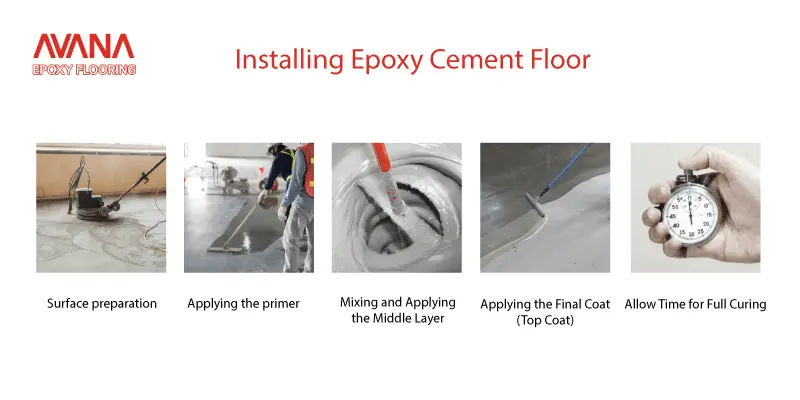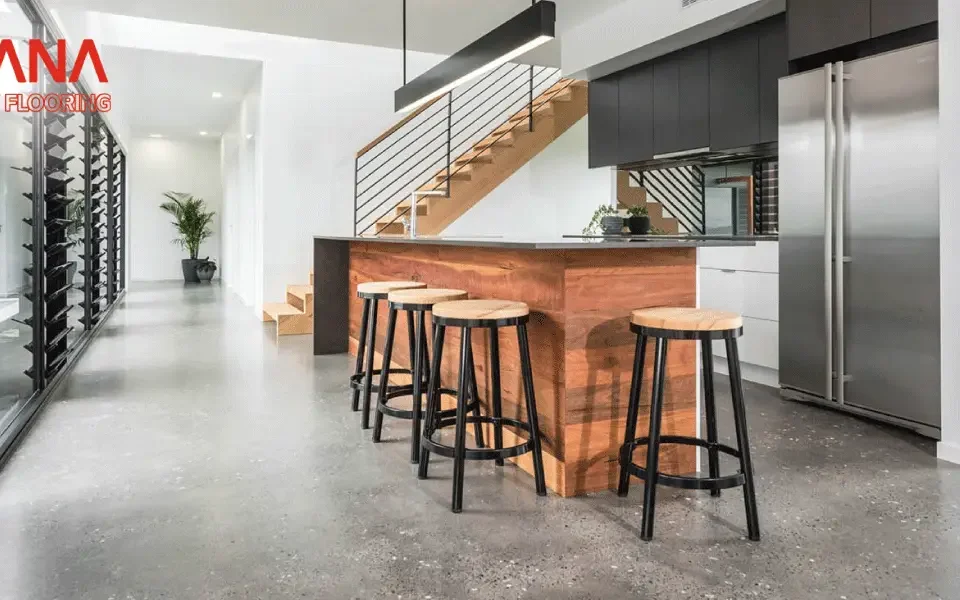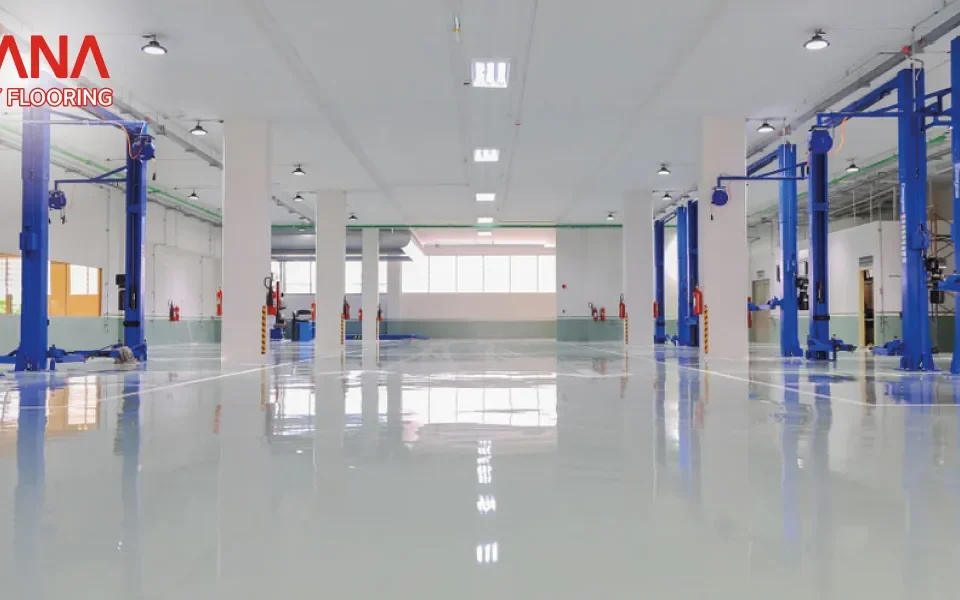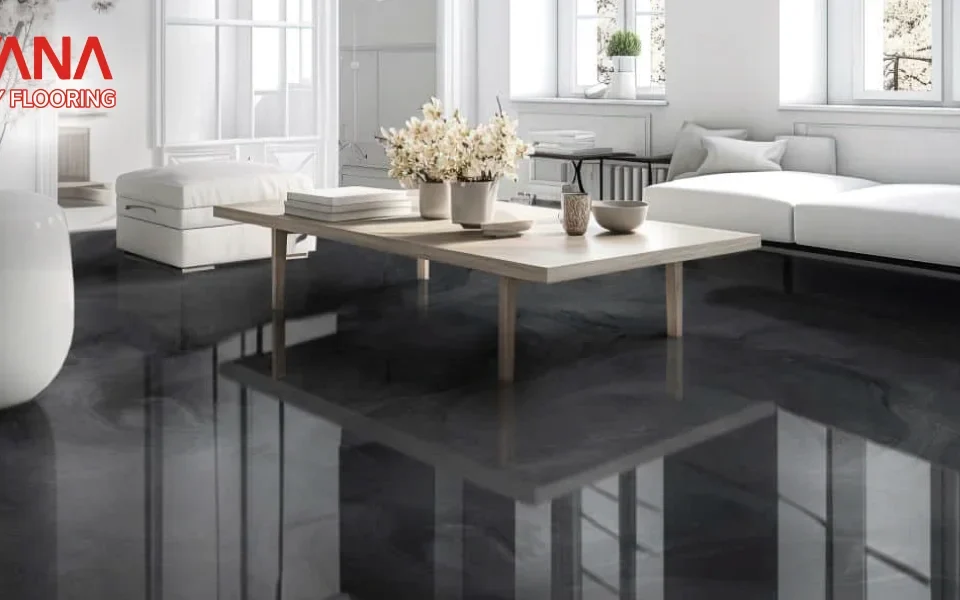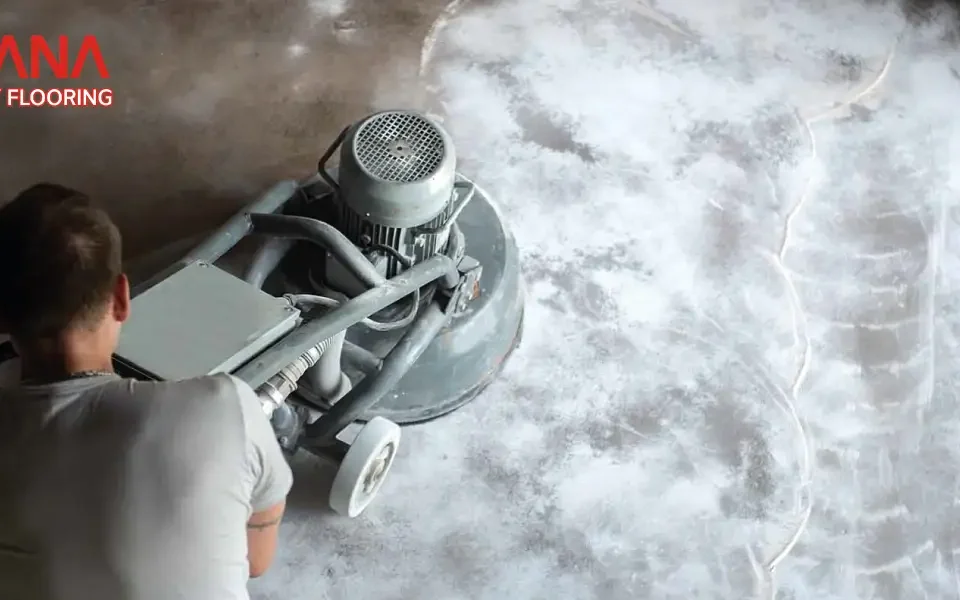Epoxy cement floor is a tough and long-lasting surface made from a combination of cement and epoxy resin.
This blend creates a seamless, hard-wearing layer that stands up well to chemicals, abrasion, and impact, making it an excellent choice for a wide range of industrial, commercial, and even residential spaces.
In this article, we’ll take a closer look at epoxy cement floors, explore their benefits and common uses, and walk you through how they’re installed. So, if you’re curious about this popular, durable, and cost-effective flooring option, keep reading—this guide will give you everything you need to know.
What is an Epoxy Cement Floor?
Epoxy cement floor is a high-performance solution used in industrial, commercial, and even residential settings. It’s made from a unique blend of modified hydraulic cement and epoxy resin, resulting in a strong, seamless, and highly durable surface. This combination offers excellent resistance to abrasion, impact, chemicals, and extreme temperatures.
What makes epoxy cement floor stand out is that it combines the strength and stability of a cement base with the superior protective and adhesive properties of epoxy resin. It’s an ideal choice whether you’re looking for industrial epoxy flooring that can handle heavy-duty conditions or a decorative epoxy floor with a clean, polished finish.
This flooring system is typically installed in three layers: primer, base (or middle) coat, and topcoat. Here’s a breakdown of what goes into each layer:
- Primer Layer: This includes epoxy primer resin, epoxy hardener, and polyurethane primer. It prepares the surface and ensures strong adhesion between the substrate and the rest of the system.
- Middle Layer: This is where the durability starts to build. It contains an epoxy resin with appropriate viscosity to create the desired thickness, epoxy hardener, modified cement powder, and fillers like silica, quartz, or other minerals. Pigments may also be added for custom color options.
- Topcoat Layer: The final layer uses a high-resistance epoxy topcoat resin designed to protect against wear, chemicals, and UV rays. It also includes epoxy hardener, polyurethane topcoat, pigments, optional anti-slip additives, and—if needed—a UV-protective sealant for extra durability.
Whether you need a floor that can withstand the demands of an industrial workspace or you’re aiming to create a sleek and stylish look in a commercial or residential space, epoxy cement flooring offers a versatile and long-lasting solution.
Key Benefits of Epoxy Cement Floors
In this part of the article, we’re going to explore the standout benefits of epoxy cement flooring. Thanks to its unique composition and performance, this flooring system offers a wide range of advantages:
1. Outstanding Durability and Long Lifespan
Epoxy cement floors are highly resistant to abrasion, impact, and heavy loads, making them an ideal choice for high-traffic areas like industrial facilities and warehouses.
2. Chemical Resistance
They hold up exceptionally well against acids, oils, solvents, and a variety of harsh chemicals. That’s why they’re commonly used in labs, workshops, industrial kitchens, and parking garages.
3. Seamless and Hygienic Surface
With no joints or grout lines, the surface doesn’t trap dust, dirt, or bacteria. It’s easy to clean and maintain, which makes it a smart choice for environments that require high hygiene standards.
4. Thermal and Temperature Shock Resistance
This flooring can withstand sudden changes in temperature without cracking or degrading, making it perfect for industrial areas with fluctuating heat and cold.
5. Strong Adhesion to Substrate
Epoxy cement flooring bonds extremely well to the surface beneath—typically concrete—so there’s minimal risk of lifting or delamination over time. It’s also compatible with epoxy finish concrete systems, making it easy to integrate into various flooring designs.
6. Fast Installation and Quick Drying Time
Compared to traditional flooring systems, epoxy cement floors can be installed faster and cure more quickly, which helps reduce downtime. Even when compared to some other epoxy systems, the preparation and return-to-service time is often shorter.
7. Improved Safety Features
Slip-resistant additives can be included in the final layer, which boosts safety in wet or high-traffic areas and helps prevent slips and falls.
8. Custom Colors, Textures, and Decorative Options
One of the great things about this flooring is its flexibility in design. You can add pigments, textures, or decorative elements like quartz or colored flakes. Whether you’re going for a rugged industrial look or a polished epoxy-based paint style for commercial or residential interiors, this flooring fits both function and form.
Where Epoxy Cement Flooring Works Best?
Thanks to its exceptional durability, chemical and mechanical resistance, long lifespan, and hygienic surface, epoxy cement floor performs brilliantly in a wide range of settings. Here’s where this flooring system truly shines:
1. Industrial Environments
Epoxy cement flooring is a top choice for factories, workshops, warehouses, logistics centers, and chemical or petrochemical industries. It stands up well to heavy machinery traffic, dropped tools, and chemical exposure from oils, greases, and industrial solvents.
Its seamless and non-porous surface is easy to clean and disinfect, helping to prevent the growth of bacteria and fungi. Thanks to its resistance to strong cleaning agents, it’s also suitable for food processing plants and pharmaceutical facilities.
In demanding settings like these, selecting the right epoxy floor materials, such as cement-based epoxy with epoxy flex technology, ensures both strength and flexibility where needed.
2. Commercial Spaces
This flooring is ideal for commercial areas that experience high traffic and chemical exposure. It can handle the wear and tear from car tires, exposure to oil, gasoline, and de-icing salts, making it perfect for multi-level parking garages and auto service centers.
Its hygienic and easy-to-clean finish also makes it suitable for hospitals, labs, gyms, retail stores, and large shopping centers, where both cleanliness and durability are essential.
For spaces that demand a balance between performance and appearance, epoxy cement flooring can even be combined with epoxy stone flooring finishes for a more decorative look.
3. Residential Applications
If you’re considering epoxy cement flooring for your home garage, you’re making a solid choice. It offers excellent resistance to oil spills, gasoline, tire wear, and dropped tools, while also providing a clean, moisture-resistant, and easy-to-maintain surface.
Beyond garages, some homeowners even use it in basements, utility rooms, or modern-style interiors where a sleek and industrial look is desired.
No matter the space—industrial, commercial, or residential—epoxy cement floor delivers performance, protection, and lasting value. Choosing the right system with quality epoxy floor materials ensures your investment pays off for years to come.
How Epoxy Cement Floors Are Installed?
In this part of the article, we’ll walk you through the step-by-step process of installing epoxy cement flooring. Whether you’re using it in an industrial facility or going for a decorative epoxy stone flooring finish, following these steps ensures a long-lasting and professional result.
1. Surface Preparation
This is the most critical step of the entire process. The final quality of your epoxy cement flooring depends heavily on how well the substrate is prepared.
Start by thoroughly cleaning the concrete surface to remove any dust, grease, oil, paint, old adhesive, loose particles, or dried mortar. Industrial vacuums, wire brushes, scrubbers, and suitable cleaning agents are usually used for this step.
Once clean, the surface needs to be roughened to improve mechanical adhesion between the concrete and epoxy layers. This is typically done using grinding or shot blasting. After roughening, all resulting dust and debris must be vacuumed away completely. The surface must be completely clean and dry before moving on.
2. Applying the Primer
The primer layer helps enhance the bond between the concrete substrate and the epoxy cement middle layer. Mix the epoxy primer resin and its hardener carefully and precisely, following the manufacturer’s ratio instructions.
Apply the mixed primer evenly over the surface using a roller, brush, or sprayer. Make sure no area is left untreated. Let it dry completely based on the product’s specifications—this can take anywhere from several hours to a full day.
3. Mixing and Applying the Middle Layer
This is the main structural layer of your epoxy cement floor—it provides thickness, strength, and performance.
In this step, you’ll mix the base epoxy resin, hardener, modified cement powder, and any additional fillers (such as silica, quartz, or fibers, if needed). The mix should follow exact proportions as specified by the manufacturer.
Once prepared, pour the mixture over the primed surface and spread it evenly. To prevent air bubbles, a spike roller may be used over the surface. Let this middle layer cure fully, which can take from one to several days depending on the material thickness and environmental conditions.
If you’re aiming for a high solids epoxy system, this is where you can introduce enhanced formulations that offer greater build and durability per coat, perfect for heavy-duty or decorative applications.
4. Applying the Final Coat (Top Coat)
Once the middle layer has dried completely, clean the surface thoroughly. If needed, a light sanding can be done to improve adhesion for the top coat.
Mix the final coat resin and its hardener according to the specified ratios, then apply it evenly using a roller, brush, or sprayer. This top coat provides chemical resistance, UV protection, and a sleek finish, especially important if you’re incorporating design elements like epoxy stone flooring.
5. Allow Time for Full Curing
Let the top coat cure fully as per the manufacturer’s guidelines. This may take several days. During this period, avoid foot traffic, dragging tools, or placing heavy objects on the surface. Once cured, your epoxy cement floor will be ready to perform, offering a seamless, durable, and attractive finish.
Epoxy Cement Floor vs Other Epoxy Flooring Options
If you’re trying to decide between different types of epoxy flooring systems, it’s helpful to understand how epoxy cement flooring compares with self-leveling epoxy and nonskid epoxy coatings.
Epoxy cement flooring is a hybrid system made by blending modified hydraulic cement with epoxy resin. This combination results in a highly durable and chemically resistant surface that can also withstand high temperatures, making it ideal for heavy-duty industrial environments.
Self-leveling epoxy, on the other hand, is made purely from epoxy resin and creates a smooth, glossy finish that levels itself out during application. Its sleek, high-end look makes it a perfect choice for commercial, hygienic, or design-focused spaces, especially when paired with decorative finishes like a wood-look epoxy floor.
Then there’s nonskid epoxy, which is designed by adding anti-slip aggregates into the epoxy mix. The goal here is maximum safety—this flooring is ideal for wet or high-traffic areas where slip resistance is a must, like locker rooms, kitchens, or ramps.
Trust the Experts for Installing Epoxy Cement Floor
In this article, we aimed to give you a clear and helpful overview of epoxy cement flooring—what it is, its key benefits, and where it can be used. We hope the information provided has helped you get familiar with this strong, high-quality flooring option.
If you’re considering installing epoxy cement floor in a residential, commercial, or industrial space, we strongly recommend working with a reputable and experienced company. A specialized team will ensure that the flooring is installed with excellent quality and attention to detail.
One professional company operating in Brisbane is AVANA Epoxy Flooring. They specialize in a wide range of epoxy flooring solutions—including epoxy cement floors—and are committed to delivering top-tier results at a fair and reasonable price.
To learn more, feel free to give them a call at 1800 28 26 21 (or 1800 AVANA1). You can also visit the AVANA Epoxy Flooring homepage, fill out the inquiry form, and leave your phone number. One of their experts will get in touch with you as soon as possible to answer your questions and provide all the information you need.


